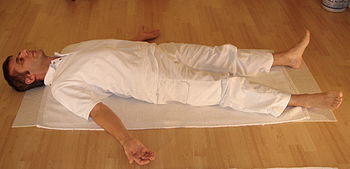Shavasana
Shavasana (Sanskrit: शवासन śavāsana to शव, śava "corpse" and आसन, āsana "seat, posture") or Mritasana (Sanskrit mṛtāsana to mṛta "dead"); In German corpse posture , resting posture or death position is the starting and often also the end position of the postures in the supine position in Hatha Yoga or Yoga Nidra .
Of all the asanas , the resting posture makes the least demands on the body. However, the resting posture is considered to be the hardest to master, as it is about "letting go of all the tension in body and mind". Shavasana is a posture typically used in yoga for relaxation at the end of a lesson or between other asanas or exercise cycles. In the corpse pose, the practitioners lie on their backs with their eyes closed, spreading their arms and legs at a 45 ° angle and concentrating on their breathing without actively influencing it. During the duration of the posture, several minutes, sometimes up to about 30 minutes, all limbs should be gradually relaxed and all control over breath, mind and body should be released. Then the relaxed posture is slowly lifted by controlled breathing and stretching of the arms and legs.
Individual evidence
- ↑ Search results for "sava". In: spokensanskrit.org . Retrieved April 28, 2020 .
- ↑ Search results for "Asana". In: spokensanskrit.org . Retrieved April 28, 2020 .
- ↑ Search results for "mrita". In: spokensanskrit.org . Retrieved April 28, 2020 .
- ↑ Leslie Kaminoff: Yoga Anatomy. Your companion through the asanas, movements and breathing techniques. Riva, Munich 2011, p. 143.
